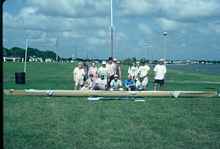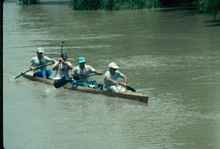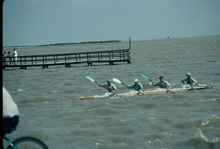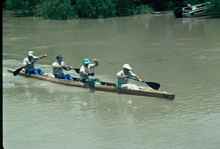
| sails |
| plans |
| epoxy |
| rope/line |
| hardware |
| canoe/Kayak |
| sailmaking |
| materials |
| models |
| media |
| tools |
| gear |
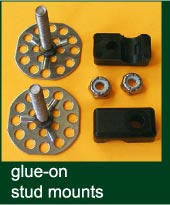 |
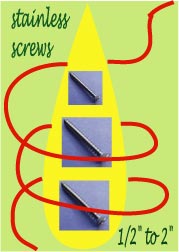 |
| join |
| home |
| indexes |
| classifieds |
| calendar |
| archives |
| about |
| links |
| Join Duckworks Get free newsletter Comment on articles CLICK HERE |
|
|
| Guest Column |
by Skip Johnson - Spring, Texas - USA An Abridged History of the Texas Long Boats |
IntroductionThe following article was written at the request of the system administrator of the paddle24seven website https://paddle24seven.com since the Texas Water Safari is getting ready for its fiftieth running Billed as "The world's toughest canoe race", it may well be. Run starting the second Saturday in June, the course 264 miles more or less from the headwaters of spring fed San Marcos River in San Marcos, Texas to a flagpole set back from the seawall at Seadrift (we are still in Texas) a small community on San Antonio Bay.
Along the way:The first 70 miles or so is narrow, twisty a touch technical in places, a couple of class II rapids and about a dozen portages, actual number depends on the water level. San Marcos River flows into the Guadalupe River and the river is slower, wider, way muddier and has a few interesting portages of its own and some log jams that might stretch for miles. To complete the course the last eight miles or so crosses San Antonio Bay which can be smooth as glass but is usually fairly choppy shading to almost impossible to cross depending on wind. It is the middle of a Texas Summer, heat and humidity is stout even for the natives. Bugs abound in the second half of the course, some sting and/or bite some of the rest just make their presence known by their numbers, at night it can be hard to breathe without some screening. Throw in some alligators, water moccasins and the occasional jumping gar that have broken a few ribs. Almost forgot, you have to carry everything you need with you except water and ice which can be supplied to you by one person only, your team captain, one of the most thankless jobs in this universe. You have four days and four hours to do the deal, competitive paddlers do it nonstop in 30 to 40 or so hours depending on water level, virtually all experience hallucinations to some degree or another, it really is a one of a kind tough event.
An Abridged History of the Texas Long Boats The Texas Water Safari is turning fifty, a golden moment in time. For almost the second half of that time the first boats to be spied from the seawall at Seadrift have been Texas Water Safari Unlimited class boats a. k. a. the Texas Long Boats. Given that the Safari is a one of a kind event it was almost inevitable that a one of a kind boat would evolve to race and win the event. What follows is my recollection of how the boats came to be. Abridged comes from the fact that my recollection only covers a small part of what transpired in the creation and evolution of these boats, others will have to tell their own part of the tale.
A short excursion into the history of personal computers is in order here. In 1982 my first personal computer was an Osborne 1 portable; size of a medium suitcase, weighed about as much as a good surfski, a monochromatic screen smaller than a smartphone and had less computing power than most high schooler's calculators. But it came with a spreadsheet application that could calculate coordinate pairs for all sorts of geometrically, mathematically pure and elegant shapes suitable for boat design. Plotting out all those points was tedious at best but the Personal Computer revolution was underway and shortly IBM compatible computers, early CAD (computer aided design) programs and clunky pen plotters were replacing triangles and t-squares, a boon for small one man architectural firms with a side passion for small boat design. Having ridden some of the heady first waves of the computer revolution, I determined there was a large untapped field of people just waiting for someone to provide a service wherein they could just specify a few parameters and receive a set of full size patterns to build the boat of their dreams. So I bundled up hardware, software and a couple of recently built boats and headed off to set up a display at the Houston Boat Show (in 1985 I think). For some reason the world didn't beat a path to my exhibit but fortunately Bill Collins did wander over and introduce himself, which is where this tale really begins.
Bill was a carpenter by trade and boat builder by avocation. Bill had already been infected with the Safari bug and introduced me to the weird and wonderful world of the Texas Water Safari. We teamed up and built a few boats, Bill's dominant passion was for row rigs having been passed easily by such a craft earlier in a Safari. I designed a solo row rig for Bill that ran well in 1987 until he got pinned on a stump near Fentress. Mine was to continue to develop and improve my understanding of what made a good boat design and to put that into practice and tried my hand at a couple of Junior Water Safari's. Then Steve Lacy appeared and things started to speed up boat design wise in 1988. Steve was a competitive paddler as well as a carpenter and boat builder. After a couple of fairly quick rounds of build and paddle, boats, mostly solo, were maturing both in building techniques and design. Then Bob Spain expressed a desire for a quick solo boat that would be fairly competitive with then current K1's but a touch more stable. Some serious discussion and a fair amount of semi educated guesswork resulted in a 20' wood stripper that fit the bill and was subsequently molded/morphed into the first Rainmaker solo canoe. A short aside here; the abridged part of the title also comes from the fact that I usually have little or no knowledge of what happens to the boat designs once the original hull is pulled off the forms.
Success up to this stage emboldened Joe Mynar to consider taking a very large leap of faith and began discussing a four man Safari boat. After some discussion and preliminary drawings, the first four man design from my computer was plotted out on one of those clackety old pen plotters and Steve Lacy commenced to quickly, as usual, build the stripper in the back of my office/warehouse. The whole team, paddlers, builder and designer laid up the Kevlar and s-glass skin. Pulled off the form, glassed inside I saw the boat head off into history in 1991. Most of the history in this case was in answering the question of how many times can you go swimming in one safari (I really don't know how many times they went swimming but it was way too many, and it was my fault). In arriving at the shape of the boat, almost all my attention was directed at the shape under water and I acceded to Joe's requirement to have the top of the gunnel pulled in to a minimum by having the sides slope up from the waterline in a gentle easy to do curve. Secondary stability was pretty much nonexistent, I felt terrible. I suppose it may have been on the belief that I surely couldn't make that big a mistake twice that Joe came back with "Let's try again". So we did, same general scenario except the design had more volume above the waterline and the boat went off to make a different kind of history. Joe, Fred, Brian Mynar, and John Dunn finished first in a series of Safaris 1994-1996 and started a trend that has led to a series of boats that had that same general cross section ever since. Turns out it's fairly easy to establish a reputation as a race boat designer; have a team of superb, competitive paddlers come to you to design them a boat and then let them go out and win races.
Another little aside, Australian, Leo (now Dr.) Lazauskas published a little shareware hydrodynamic analysis program, Mitchlet, in 1999 that included an optimization routine called Godzilla (a program for the truly hydro dynamically obsessed). When Bob Spain's solo boat and Joe Mynars' 4 man boat were reanalyzed using Mitchlet and Godzilla the optimum solutions were extremely close what was originally done by guess and by gosh. Sometimes the fates smiles on the earnest, even when they truly don't have much of a clue. Vaguely resembling an arms race, the push for an extra edge continued with a change to molded multiman boats and fairly close to state of the art materials and techniques. Carbon fiber, Kevlar, vacuum bagging even autoclaving entered the picture. Most of this work was done by the three "J's"; Jack Spencer, Jay Daniel and John Bugge (another "J" in the mix was Jerry Cochran). Certainly not in concert with each other, there's competition on this front also, but I have to plead ignorance of any direct knowledge on this front, once a design left my office and the first boat (or plug in some cases) was done I rarely if ever was consulted on subsequent molding, stretching, tweaking or other modifications that were done. On another front that I was involved with concerned the number of paddlers. Closely following the gearheads motto "There's no substitute for cubic inches" if four is better than three, five must be better than four, six better than five, ad infinitum. Once people were seriously talking about nine man boats (!!!!!) the rules were revised to state that unlimited was limited to six paddlers. I'll have to admit that a part of me mourns the loss of absolutes in the rule change as a matter of principle but at a technical level not much, if any, harm was done. Everything else being equal (an absurdity, things are never equal) a good measure of goodness for a boat is how much wetted surface each paddler is dragging down the river. A solo paddler might be dragging twenty square feet or more of hull surface through the water. In a tandem, each paddler would have closer to seventeen square feet to deal with, in a three man boat it's down to fifteen feet or so. In a four man boat each paddler is pulling about twelve square feet of hull through the water. Stretch the boat out a little bit add a man and each paddler is still dealing with around twelve square feet, the curve is flattening out. By the time you get to a six man boat the curve is essentially flat. The other major factor holding boats back is wave making drag, a technically complex subject figuring largely in why things are never equal. But once Safari boats get up into the around forty foot or so long craft of today it's possible to shape the hulls so that at the speeds typically run, the boats hardly leave a ripple. I have to admit that I'll always get a small thrill when I see a six man boat at speed paddles flashing in unison like they are wired together. If there's the least bit of breeze to ripple the water you can't make out the wake behind the boat, I'm honored to have had a part in that. With the unlimited boats limited to six paddlers there is still room for incremental improvements. Building materials and techniques will continue to evolve leading to lighter and tougher boats, and tough is important in this race. Training and nutrition will continue to improve. Paddles have evolved to bent shaft singles and winged doubles, who knows what, will come next. Design wise there are improvements possible particularly in rudders and reducing skin drag. Given that there are no limitations to the human power (other than the number of); row rigs might reappear, or an alternate form of delivering leg drive might be possible, particularly for a solo boat. Some notable attempts at propeller driven craft have tried over the years but shallow water and portages have always taken their toll. At the most basic, fundamental level though; it is still all about the paddlers. A boat has never won the Safari, the very best that a boat can hope to be is to be well matched to the paddlers it carries in the event that's run. I've been compelled and honored to have been a part of that quest to provide the best boat possible. Looking back on it all; the Texas Water Safari truly is an extraordinary event populated with extraordinary people. For a puny little patch people commit significant portions of their lives just to finish the event. To compete to win requires almost superhuman commitment to prepare for an almost superhuman effort, still for a patch. For the people mentioned in this little memoir and the multitude of other Safari aficionados not mentioned who have been parts of the journey, my heartfelt thanks for having been a part of the craziness. |
